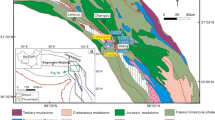Abstract
Lead-zinc deposits in the Meixian area, Fujian Province, China, consist mainly of stratiform sphalerite-galena ores in the upper Proterozoic metamorphic rocks. δ34S values of sulfide minerals (sphalerite, galena, pyrrhotite, and pyrite) range from −3.3 to +4.2‰. These sulfur isotope values indicate that the sulfur was mainly derived from an igneous source rather than from a reduction of seawater sulfate. Lead isotope compositions of the ore minerals show relatively high207Pb/206Pb values, suggesting the contribution of crustal lead with high radiogenic components.
Similar content being viewed by others
References
Doe, B.R. and Zartman, Z.E., 1979, Plumbotectonics, the Phanerozoic. In: Barnes, H.L. (ed.), Geochemistry of Hydrothermal Ore Deposits. John Wiley, New York, p. 22–70.
Fehn, U., Doe, B.R. and Delevaux, M.H., 1983, The distribution of lead isotopes and the origin of Kuroko ore deposits in the Hokuroku district. Economic Geology Monograph, 5, 488–506.
Fritz, P., Drimmie, R.J. and Nowicki, V.K., 1974, Preparation of sulfur dioxide for mass spectrometer analyses by combustion of sulfides with copper oxide. Analytical Chemistry, 46, 164–166.
KOICA (Korea International Cooperation Agency) and KMPC (Korea Mining Promotion Corporation), 1995, The Comprehensive Geological Exploration for Lead and Zinc Mineral Resources in the Meixian Area, Fujian Province, China. Final Report—Phase I, KOICA and KMPC, Seoul. 272 p.
Ohmoto, H. and Rye, R.O., 1974, Hydrogen and oxygen isotopic compositions of fluid inclusions in the Kuroko deposit, Japan. Economic Geology, 69, 947–953.
Ohmoto, H. and Rye, R.O., 1979, Isotopes of sulfur and carbon. In: Barnes, H.L. (ed.), Geochemistry of Hydrothermal Ore Deposits (2nd edn.), John Wiley, New York, p. 509–567.
Ripley, E.M. and Ohmoto, H., 1977, Mineralogic, sulfur isotope, and fluid inclusion studies of the stratabound copper deposits at the Raul Mine, Peru. Economic Geology, 72, 1017–1041.
Sangster, D.F., 1968, Relative sulfur isotope abundance of ancient seas and stratabound sulphide deposits. Proceedings of Geological Association of Canada, 19, 79–86.
Zartman, R.E. and Doe, B.R., 1981, Plumbotectonics—the model. Tectonophysics, 75, 135–162.
Author information
Authors and Affiliations
Rights and permissions
About this article
Cite this article
Lee, I., Park, KH. A preliminary sulfur and lead isotopic study of lead-zinc deposits in the Meixian area, Fujian Province, China. Geosci J 1, 57–60 (1997). https://doi.org/10.1007/BF02910451
Received:
Accepted:
Issue Date:
DOI: https://doi.org/10.1007/BF02910451



